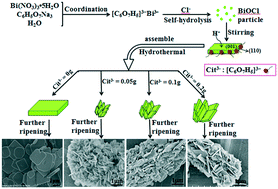One dimensional hierarchical BiOCl microrods: their synthesis and their photocatalytic performance
Abstract
In this work, one dimensional hierarchical BiOCl microrods were controllably synthesized via a hydrothermal method using sodium citrate as the structure-directing agent. Each hierarchical BiOCl structure is made up of many BiOCl nanosheets in which the size and thickness are controlled by the concentration of sodium citrate. The high-resolution transmission electron microscopy (HRTEM) measurements show that each nanosheet consists of the BiOCl hierarchical structure with exposed (001) (top surface) and (110) (side surface) facets. With the amount of sodium citrate increasing, the ratio (110)/(001) gradually increases. These hierarchical BiOCl architectures exhibit a more outstanding photocatalytic activity than BiOCl nanosheets with exposed (001) facets, and rhodamine B (RhB) and methyl orange (MO) can be degraded in 3 and 4 min, respectively. This enhanced photocatalytic performance is ascribed to the fast separation and transfer of photogenerated electron–hole pairs, the formation of hierarchical architectures and the large BET surface areas. Radical scavenger experiments indicate that holes (h+) and superoxide radicals (˙O2−) are the main active species for MO degradation during the photocatalytic process.



 Please wait while we load your content...
Please wait while we load your content...